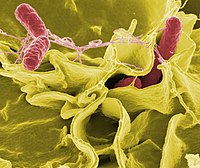
Photo from wikipedia
In this study, we showed that doping bismuth (Bi) at the surface of Fe0 (Bi/Fe0, bimetallic iron system)—synthesized by a simple borohydride reduction method—can considerably accelerate the reductive degradation of… Click to show full abstract
In this study, we showed that doping bismuth (Bi) at the surface of Fe0 (Bi/Fe0, bimetallic iron system)—synthesized by a simple borohydride reduction method—can considerably accelerate the reductive degradation of chloramphenicol (CHP). At a reaction time of 12 min, 62, 68, 74, 95, and 82% degradation of CHP was achieved with Fe0, Bi/Fe0-1 [1% (w/w) of Bi], Bi/Fe0-3 [3% (w/w) of Bi], Bi/Fe0-5 [5% (w/w) of Bi], and Bi/Fe0-8 [8% (w/w) of Bi], respectively. Further improvements in the degradation efficiency of CHP were observed by combining the peroxymonosulfate (HSO5–) with Bi/Fe0-5 (i.e., 81% by Bi/Fe0-5 and 98% by the Bi/Fe0-5/HSO5– system at 8 min of treatment). Interestingly, both Fe0 and Bi/Fe0-5 showed effective H2 production under dark conditions that reached 544 and 712 μM by Fe0 and Bi/Fe0-5, respectively, in 70 mL of aqueous solution containing 0.07 g (i.e., at 1 g L–1 concentration) of the catalyst at ambient temperature.
Journal Title: ACS Omega
Year Published: 2020
Link to full text (if available)
Share on Social Media: Sign Up to like & get
recommendations!